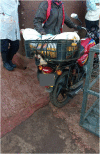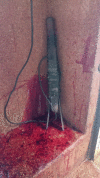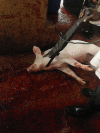Prevalence of gross lesions and handling practices in pigs and their association with pork quality, Kiambu, Kenya
- PMID: 36026517
- PMCID: PMC9417192
- DOI: 10.1371/journal.pone.0272951
Prevalence of gross lesions and handling practices in pigs and their association with pork quality, Kiambu, Kenya
Abstract
Pre-slaughter handling of pigs has been documented to affect the quality of meat though no studies have investigated this relationship in the Kenyan context. This study aimed to determine the prevalence of gross lesions and practices related to sub-optimal welfare in pigs presented for slaughter while analyzing the relationship between occurrence of these lesions and meat quality. A cross-sectional study was conducted at a medium scale, non-integrated pig abattoir supplying to the Nairobi market, with a capacity to slaughter approximately 40 pigs a day. Data on welfare-associated lesions and handling practices were obtained from 529 pig carcasses and traders respectively. 387 pork samples were collected, and their quality evaluated by measuring their pH, meat color and drip loss. These three parameters were used to classify pork into four recognized categories namely: Red, Firm, Non-exudative (RFN), Pale Soft Exudative (PSE), Dark Firm Dry (DFD) and Red Soft Exudative (RSE). Almost all pigs were inefficiently stunned as evidenced by the presence of consciousness post-stunning. The majority of pigs (82.97%) having one or more welfare-associated gross lesions. Other animal welfare malpractices observed were high loading density and inadequate rest periods between transport and slaughter. A quarter of the pork samples were of sub-optimal quality including: RSE (11.36%), PSE (2.58%) and DFD (2.58%). Multinomial logistic regression revealed that pork originating from pigs transported at a high loading density had increased odds of being classified as DFD (OR 13.41, 95% CI 2.59-69.46). The findings indicate the need to educate stakeholders in the pork value chains on improved pig handling before and during slaughter to enhance pig welfare pre-slaughter and pork quality post-slaughter. Animal welfare legislation enforcement and implementation was observed to be insufficient. There is a need to educate key stakeholders on its importance of being put into practice both from economic and welfare perspectives.
Conflict of interest statement
The authors have declared that no competing interests exist.
Figures







Similar articles
-
Can the monitoring of animal welfare parameters predict pork meat quality variation through the supply chain (from farm to slaughter)?J Anim Sci. 2016 Jan;94(1):359-76. doi: 10.2527/jas.2015-9176. J Anim Sci. 2016. PMID: 26812341
-
Fasting Finisher Pigs before Slaughter Influences Pork Safety, Pork Quality and Animal Welfare.Animals (Basel). 2020 Nov 25;10(12):2206. doi: 10.3390/ani10122206. Animals (Basel). 2020. PMID: 33255610 Free PMC article. Review.
-
Preslaughter handling practices and their effects on animal welfare and pork quality.J Anim Sci. 2018 Mar 6;96(2):728-738. doi: 10.1093/jas/skx064. J Anim Sci. 2018. PMID: 29401265 Free PMC article.
-
Halothane genotype, pre-slaughter handling and stunning method all influence pork quality.Meat Sci. 2000 Nov;56(3):291-9. doi: 10.1016/s0309-1740(00)00056-5. Meat Sci. 2000. PMID: 22062081
-
Optimal lairage times and conditions for slaughter pigs: a review.Vet Rec. 2003 Aug 9;153(6):170-6. doi: 10.1136/vr.153.6.170. Vet Rec. 2003. PMID: 12934728 Review.
Cited by
-
A qualitative exploration of the enablers of and barriers to conformance with antibiotic withdrawal periods on smallholding, peri-urban pig farms in Kiambu County, Kenya.PLoS One. 2025 Jan 10;20(1):e0312362. doi: 10.1371/journal.pone.0312362. eCollection 2025. PLoS One. 2025. PMID: 39792866 Free PMC article.
-
Consequences of Transport Conditions on the Welfare of Slaughter Pigs with Different Health Status and RYR-1 Genotype.Animals (Basel). 2024 Jan 6;14(2):191. doi: 10.3390/ani14020191. Animals (Basel). 2024. PMID: 38254360 Free PMC article.
-
Preslaughter practices, pork physicochemical attributes and fatty acid profiles of pigs raised and slaughtered on smallholder urban farms in the Cape Metropole, South Africa.Vet Anim Sci. 2025 Apr 14;28:100454. doi: 10.1016/j.vas.2025.100454. eCollection 2025 Jun. Vet Anim Sci. 2025. PMID: 40290100 Free PMC article.
-
Prevalence of Antibiotic Residues in Pork in Kenya and the Potential of Using Gross Pathological Lesions as a Risk-Based Approach to Predict Residues in Meat.Antibiotics (Basel). 2023 Mar 1;12(3):492. doi: 10.3390/antibiotics12030492. Antibiotics (Basel). 2023. PMID: 36978359 Free PMC article.
-
Exploring the pork production chain in urban Ghana: insights from focus group discussions.BMC Vet Res. 2025 May 20;21(1):362. doi: 10.1186/s12917-025-04818-5. BMC Vet Res. 2025. PMID: 40389952 Free PMC article.
References
-
- Szűcs I, Vida V. Global tendencies in pork meat—production, trade and consumption. Appl Stud Agribus Commer. 2017;11: 105–111. doi: 10.19041/apstract/2017/3-4/15 - DOI
-
- FAO. Livestock Country Reviews. FAO Animal Production and Health Livestock Country Reviews. No. 3. Rome. Authors’. 2012.
-
- Nantima N, Ocaido M, Davies J, Dione M, Okoth E, Mugisha A, et al. Characterization of smallholder pig production systems in four districts along the Uganda-Kenya border. Livest Res Rural Dev. 2015;27.
-
- FAO. State Of Food and Agriculture. FAO. Rome; 2011. doi: 10.1007/978-3-030-44988-9_8 - DOI
-
- Mosoti Mburugu. THE PORK VALUE CHAIN:A Review of the actors and the business opportunities in the sector,in Kenya. 2014; 1–11.
Publication types
MeSH terms
Grants and funding
LinkOut - more resources
Full Text Sources

